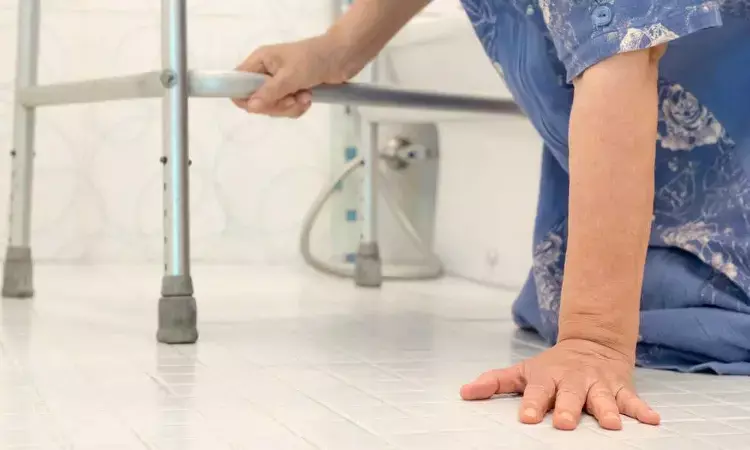- Home
- Medical news & Guidelines
- Anesthesiology
- Cardiology and CTVS
- Critical Care
- Dentistry
- Dermatology
- Diabetes and Endocrinology
- ENT
- Gastroenterology
- Medicine
- Nephrology
- Neurology
- Obstretics-Gynaecology
- Oncology
- Ophthalmology
- Orthopaedics
- Pediatrics-Neonatology
- Psychiatry
- Pulmonology
- Radiology
- Surgery
- Urology
- Laboratory Medicine
- Diet
- Nursing
- Paramedical
- Physiotherapy
- Health news
- Fact Check
- Bone Health Fact Check
- Brain Health Fact Check
- Cancer Related Fact Check
- Child Care Fact Check
- Dental and oral health fact check
- Diabetes and metabolic health fact check
- Diet and Nutrition Fact Check
- Eye and ENT Care Fact Check
- Fitness fact check
- Gut health fact check
- Heart health fact check
- Kidney health fact check
- Medical education fact check
- Men's health fact check
- Respiratory fact check
- Skin and hair care fact check
- Vaccine and Immunization fact check
- Women's health fact check
- AYUSH
- State News
- Andaman and Nicobar Islands
- Andhra Pradesh
- Arunachal Pradesh
- Assam
- Bihar
- Chandigarh
- Chattisgarh
- Dadra and Nagar Haveli
- Daman and Diu
- Delhi
- Goa
- Gujarat
- Haryana
- Himachal Pradesh
- Jammu & Kashmir
- Jharkhand
- Karnataka
- Kerala
- Ladakh
- Lakshadweep
- Madhya Pradesh
- Maharashtra
- Manipur
- Meghalaya
- Mizoram
- Nagaland
- Odisha
- Puducherry
- Punjab
- Rajasthan
- Sikkim
- Tamil Nadu
- Telangana
- Tripura
- Uttar Pradesh
- Uttrakhand
- West Bengal
- Medical Education
- Industry
Overactive Bladder significantly associated with falls in Older Adults

Falls leading to physical trauma and restriction of activity are among the principal causes of morbidity in the elderly. In a study, researchers have reported that both wet and dry overactive bladder was significantly associated with falls. They recommend physicians for earlier intervention by simple questionnaire to prevent fall among this population. The study findings were published in The Journal of Urology on January 01, 2021.
About 40% of all serious fall injuries among the elderly resulted in
hospital admission and, after hospitalization, 30–40% of these patients are transferred to a nursing home. As a consequence, the health care costs associated with falls and fall-related injuries are high. These facts highlight the importance of further investigation into other predictable and preventable underlying risk factors for falls in older adults. Little is known about the fall risk of older adults with overactive bladder, especially in the absence of urgency incontinence. Therefore, researchers of Japan conducted a study to evaluate the impacts of overactive bladder with and without urgency incontinence (overactive bladder wet and overactive bladder dry) on the fall risk in older adults and investigated the importance of overactive bladder as a predictor of falls by using tree-based models.
It was a prospective cohort study of 630 community-dwelling, independent older adults of 75 years old or older who attended a health checkup in 2017 with a 1-year follow-up. Researchers used logistic regression models to assess the association between the overactive bladder (dry and wet) with a fall history, and future fall risk compared to no overactive bladder. They also used random forest and decision tree approach to examine the contribution of the overactive bladder as a predictor of falls.
Key findings of the study were:
- At baseline, the researchers noted that the prevalence of overactive bladder dry and overactive bladder wet was 15% and 14%, respectively.
- Upon multivariable logistic regression analysis, they found that both overactive bladder dry and overactive bladder wet were associated with a higher likelihood of prior falls (adjusted ORs vs no overactive bladder 2.03 and 2.21).
- They also found that the odds of a future fall within one year among the 363 participants without a fall history were 2.7- and 1.4-fold higher with OAB dry and wet, respectively.
- The tree-based model confirmed that overactive bladder was an important predictor of falls in adults without a fall history with 83.6% accuracy and 81.8% AUC.
The authors concluded, "Overactive bladder, even in the absence of urgency incontinence, is an important predictor of falls in older adults with a low absolute fall risk."
For further information:
Dr Kartikeya Kohli is an Internal Medicine Consultant at Sitaram Bhartia Hospital in Delhi with super speciality training in Nephrology. He has worked with various eminent hospitals like Indraprastha Apollo Hospital, Sir Gangaram Hospital. He holds an MBBS from Kasturba Medical College Manipal, DNB Internal Medicine, Post Graduate Diploma in Clinical Research and Business Development, Fellow DNB Nephrology, MRCP and ECFMG Certification. He has been closely associated with India Medical Association South Delhi Branch and Delhi Medical Association and has been organising continuing medical education programs on their behalf from time to time. Further he has been contributing medical articles for their newsletters as well. He is also associated with electronic media and TV for conduction and presentation of health programs. He has been associated with Medical Dialogues for last 3 years and contributing articles on regular basis.
Dr Kamal Kant Kohli-MBBS, DTCD- a chest specialist with more than 30 years of practice and a flair for writing clinical articles, Dr Kamal Kant Kohli joined Medical Dialogues as a Chief Editor of Medical News. Besides writing articles, as an editor, he proofreads and verifies all the medical content published on Medical Dialogues including those coming from journals, studies,medical conferences,guidelines etc. Email: drkohli@medicaldialogues.in. Contact no. 011-43720751


